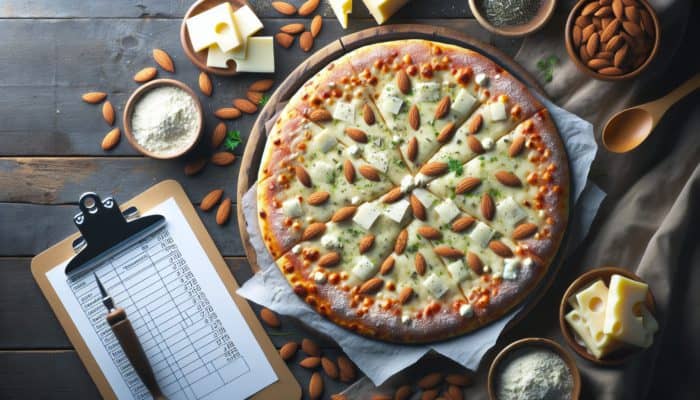Unlock the Culinary Potential of Low-Carb Pizza Dough for Delicious Meals
Explore the Unique Advantages of Low-Carb Pizza Dough for Health-Conscious Food Lovers

The emergence of low-carb pizza dough serves as an exhilarating alternative to traditional pizza bases, carefully crafted for those aiming to reduce their carbohydrate intake while still enjoying mouthwatering meals. This groundbreaking concept is particularly embraced by individuals following ketogenic diets, which prioritize minimizing carbohydrate consumption to promote effective weight loss and maintain stable blood sugar levels. By incorporating alternative flours and unique ingredients, low-carb pizza dough achieves an enticing texture and flavor, allowing you to indulge in your favorite meals without the guilt that typically accompanies high-carb options.
Moreover, the versatility of low-carb dough presents limitless possibilities for creating various styles of pizza, ranging from the timeless Margherita to more adventurous toppings that cater to a wide array of tastes. The key is to select the right blend of ingredients to formulate a dough that not only excites your palate but also aligns with specific dietary preferences and restrictions.
Discover the Health Benefits of Incorporating Low-Carb Dough into Your Diet
Choosing low-carb dough comes with numerous advantages, making it an appealing option for many individuals. One of the most significant benefits is its ability to effectively manage blood sugar levels. Conventional pizza dough is often laden with refined carbohydrates, which can cause abrupt spikes in blood sugar, particularly troublesome for individuals managing diabetes or dealing with insulin resistance. Low-carb alternatives help mitigate this effect, providing a more consistent energy supply throughout the day.
Additionally, incorporating low-carb dough into your meals can greatly assist in your weight loss journey. By decreasing carbohydrate consumption, your body may enter a state of ketosis, which allows it to burn fat for energy instead of sugars. This metabolic transition not only supports weight reduction but can also enhance mental clarity and focus. For individuals adhering to restrictive diets, low-carb pizza dough emerges as a satisfying meal option that never compromises on flavor or enjoyment.
Essential Ingredients for Crafting Irresistible Low-Carb Pizza Dough
When embarking on the quest to create the perfect low-carb pizza dough, the choice of ingredients is critical. Commonly used components include almond flour, coconut flour, cheese, and eggs.
- Almond flour: This gluten-free flour boasts low carbohydrate content while being rich in protein and healthy fats, delivering a delightful nutty flavor that enriches the overall dough experience.
- Coconut flour: A versatile substitute that imparts a mild coconut taste, it is highly absorbent and typically necessitates more liquid than other flours to achieve the desired consistency.
- Cheese: Usually mozzarella or cream cheese, it adds richness and acts as a binding agent, enhancing both the flavor and texture of the dough.
- Eggs: Acting as a binding agent, eggs provide structure and moisture, making the dough easier to handle during preparation.
Combined, these ingredients create a dough that is not only low in carbohydrates but also bursting with flavor and satisfaction, paving the way for endless culinary creativity.
Explore Top Recipes for Exceptional Low-Carb Pizza Dough

What Are the Most Popular and Time-Tested Low-Carb Pizza Recipes?
In the realm of low-carb pizza dough, a multitude of recipes have received accolades from both culinary experts and enthusiastic home cooks. Below is a curated selection of cherished recipes that highlight the versatility of low-carb ingredients:
- Almond Flour Pizza Crust: This crust, made from almond flour, mozzarella cheese, eggs, and seasonings, strikes an ideal balance between heaviness and crispiness, making it a favorite among pizza aficionados.
- Coconut Flour Pizza Base: A mixture of coconut flour, eggs, and cheese results in a light base with a subtle coconut flavor, perfect for adventurous eaters.
- Cauliflower Pizza Crust: Grated cauliflower combined with cheese and eggs offers a gluten-free, vegetable-rich option that is both nutritious and tasty.
- Fathead Dough: A widely loved choice made from almond flour and mozzarella, yielding a remarkably stretchy and satisfying dough that many people adore.
These examples showcase the diverse array of ingredients available and demonstrate how simple it is to prepare a delightful low-carb pizza base in the comfort of your own home.
Steps to Successfully Create Low-Carb Dough at Home
Making low-carb pizza dough is a straightforward process that anyone can master with a few easy steps. Here’s an efficient guide to preparing your dough:
- Combine the Ingredients: Begin by mixing your chosen flour (either almond or coconut), cheese, eggs, and any seasonings in a mixing bowl until everything is well blended, ensuring even flavor distribution.
- Knead the Dough: After mixing, knead the dough until it reaches a smooth consistency, making sure all ingredients are thoroughly combined for a cohesive texture.
- Roll Out the Dough: Transfer the dough to a floured surface and roll it out to your desired thickness, remembering that thinner crusts will yield a crunchier finish, enhancing your eating experience.
- Preheat Your Oven: While preparing the dough, preheat your oven to approximately 220°C for optimal baking results, ensuring that the crust rises to perfection.
By following these steps, even beginners can achieve remarkable results, crafting a low-carb pizza crust that is both satisfying and versatile, ready for a variety of toppings.
Achieving the Perfect Texture and Flavor in Your Low-Carb Dough

The texture and flavor of low-carb pizza dough are key components that significantly influence the overall pizza experience. Achieving the perfect dough requires a nuanced understanding of ingredient balance. For instance, combining almond flour and mozzarella cheese yields a slightly chewy texture that closely resembles traditional pizza dough. In contrast, coconut flour can introduce a light and airy quality that some individuals might prefer for a different pizza experience.
In terms of flavor, adding herbs and spices such as garlic powder or Italian seasoning can greatly enhance the flavor profile of your pizza base. A valuable tip is to experiment with various cheese types; incorporating cream cheese can create a creamier texture, while blending different cheeses can result in a more intricate flavor profile that tantalizes your taste buds.
Ultimately, the ideal low-carb pizza dough achieves a beautiful balance between texture and flavor, ensuring that every bite is both satisfying and delicious, making it a delightful addition to your dining repertoire.
Exploring Customization Options and Variations with Low-Carb Dough
The true allure of low-carb pizza dough lies in its adaptability, allowing for various dietary preferences and flavor profiles. The potential for variations and customizations is virtually limitless, empowering you to tailor recipes to align with your unique tastes and desires.
If you thrive on culinary experimentation, consider incorporating spices directly into the dough. Adding crushed red pepper flakes can deliver a pleasant heat, while Italian herbs can introduce an aromatic flair that enhances the overall experience. Additionally, think about substituting traditional mozzarella with alternative cheese varieties like cheddar or parmesan to modify the flavor and texture profile. For those seeking a nut-free alternative, options such as flaxseed or sunflower seed flour can be utilized. These substitutes introduce distinct flavors and nutritional benefits while maintaining a low carbohydrate count, effectively satisfying your cravings.
The possibilities with low-carb pizza dough are virtually endless, granting you the freedom to create a dish that perfectly aligns with your culinary interests and dietary requirements, transforming each pizza night into a new culinary adventure.
Mastering the Art of Creating Low-Carb Pizza Dough
Essential Steps for Crafting Impeccable Low-Carb Pizza Dough
Creating low-carb pizza dough involves several simple steps that ensure a successful result. Follow these essential guidelines to craft your dough:
- Gather Your Ingredients: Begin by collecting all necessary ingredients, including your preferred low-carb flour, cheese, eggs, and any desired seasonings to enhance flavor.
- Combine the Dough: Start by mixing the dry ingredients, then incorporate the cheese and eggs, blending until a cohesive dough forms. Knead the mixture for a few minutes until it reaches a smooth and elastic texture, ensuring even distribution of all components for optimal results.
- Allow the Dough to Rest: Let the dough sit for about 10-15 minutes, allowing it to improve in texture and making it easier to roll out for perfect crusts.
- Shape the Dough: Once rested, roll out the dough to your preferred thickness and shape, preparing it for the baking process.
By adhering to these steps, you can create a low-carb pizza dough that is both flavorful and easy to prepare, setting the stage for delicious homemade pizzas that will impress family and friends alike.
Streamlining Low-Carb Dough Creation with a Food Processor
Utilizing a food processor can significantly simplify the process of making low-carb pizza dough. This versatile kitchen appliance allows for quick mixing and kneading of ingredients, saving precious time for busy home cooks. To use a food processor, start by adding the dry ingredients, followed by the cheese and eggs, and then pulse until the mixture forms a cohesive ball of dough.
This method not only reduces preparation time but also ensures that all ingredients are evenly mixed, which is crucial for achieving the desired texture. For those who find traditional mixing methods tedious, using a food processor can revolutionize the process, enabling you to whip up low-carb pizza dough in just minutes and focus on the enjoyable part—adding toppings!
Optimal Resting Time for Dough to Achieve Ideal Results
Allowing your low-carb pizza dough to rest is a pivotal step that can significantly enhance its texture. A resting period of approximately 10-15 minutes is ideal, as it allows the ingredients to meld and the gluten structure to relax, which is essential for crafting a dough that is easy to work with. When gluten is permitted to rest, the dough becomes more pliable and easier to roll out, an important factor for achieving even thickness and a perfect bake.
During this resting phase, the starches in the flour can fully hydrate, resulting in a more robust overall structure once baked. Skipping the resting step can lead to a tougher texture and make shaping the dough more challenging. Therefore, giving your dough a moment to relax is an integral part of creating a delightful low-carb pizza crust that you and your family will cherish.
Indispensable Ingredients for Low-Carb Pizza Dough
When creating low-carb pizza dough, certain ingredients are integral to ensuring a successful and flavorful outcome. The following components are essential:
- Almond flour: This primary flour used in numerous low-carb recipes offers a subtle nutty flavor and low carbohydrate content, making it a popular choice among health-conscious individuals.
- Mozzarella cheese: Crucial for binding the dough and adding richness, mozzarella helps create a stretchy, chewy crust that closely resembles traditional pizza.
- Eggs: Serving as a binder, eggs provide structure and moisture, facilitating ease of handling during preparation and ensuring a pleasant texture.
- Seasonings: Incorporating herbs and spices like garlic powder, oregano, or basil enhances the flavor and aroma of the crust, elevating your pizza experience.
Together, these ingredients form the foundation of a delectable low-carb pizza dough that can satisfy even the most discerning pizza enthusiasts, solidifying its status as a staple in your culinary repertoire.
Steps for Baking the Dough to Perfection
Baking your low-carb pizza dough to perfection involves several key steps to ensure a crispy and flavorful crust. Start by preheating your oven to 220°C, allowing it to reach the optimal temperature for effective baking. Once your dough is rolled out to your desired thickness, place it on a baking sheet lined with parchment paper or a greased pizza stone to ensure even baking.
Bake the crust for about 10-15 minutes or until it turns golden brown. This initial baking period helps set the structure of the dough, ensuring it can support the weight of your toppings without becoming overly soft or soggy. To achieve the best texture, keep a close eye on the crust as it bakes, particularly during the final minutes, as oven temperatures may vary. Following these baking instructions will yield a low-carb pizza crust that is not only delicious but also features a satisfying crunch that perfectly complements your favorite toppings.
Optimal Ingredients for Crafting Low-Carb Pizza Dough
Why Almond Flour Is a Preferred Choice
Almond flour is a foundational ingredient in many low-carb pizza dough recipes, celebrated for its numerous health benefits and culinary versatility. Its low carbohydrate content, in comparison to traditional wheat flour, makes it an excellent choice for individuals aiming to reduce their carbohydrate intake while still relishing flavorful meals. Almond flour is also nutrient-dense, offering essential vitamins and minerals, healthy fats, and ample protein, making it a nourishing addition to any meal plan.
Incorporating almond flour into your pizza dough not only enhances its nutritional profile but also imparts a subtle nutty flavor and satisfying texture. The grainy consistency of almond flour provides a pleasant chew that mimics the experience of traditional pizza, making it a favorite among those on low-carb diets. Its versatility extends beyond pizza dough, as it can also be utilized in various baked goods, allowing for extensive culinary creativity and experimentation.
Is Coconut Flour a Viable Substitute?
Coconut flour is another excellent option for low-carb pizza dough, renowned for its absorbent properties and mild coconut flavor. While it differs significantly from almond flour in texture and moisture retention, it offers a unique profile that can be advantageous for specific recipes. One of the notable benefits of coconut flour is that it is naturally gluten-free, making it an attractive choice for individuals with gluten sensitivities or allergies.
However, it is essential to recognize that coconut flour requires a higher liquid-to-flour ratio, necessitating adjustments when incorporating it into pizza dough recipes. A good rule of thumb is to use approximately one-quarter of the amount of coconut flour compared to other flours, increasing the liquid content accordingly. This adjustment guarantees that the dough maintains the proper consistency while still delivering an enjoyable texture and flavor that everyone can appreciate.
How Cheese Enhances the Dough Experience
Integrating cheese into low-carb pizza dough is not only acceptable but often recommended, as it can significantly enhance both the flavor and texture of the crust. Cheese, particularly mozzarella, contributes to the dough’s elasticity, allowing it to stretch and hold together beautifully during baking. This characteristic closely resembles traditional pizza crusts, making it an appealing option for those seeking a low-carb alternative without sacrificing the classic experience.
In addition to boosting flavor, adding cheese can also enrich the dough with nutritional value, contributing protein and calcium, thus making your low-carb pizza a more balanced meal that satisfies your cravings. For those who enjoy a cheesier base, experimenting with different cheese varieties, such as cheddar or parmesan, can further customize the taste of your pizza crust while adhering to low-carb dietary guidelines.
Proven Techniques for Crafting Superior Low-Carb Pizza Dough
How to Effectively Experiment with Different Flours
One of the most exciting aspects of creating low-carb pizza dough is the opportunity to experiment with various types of low-carb flours. Each flour offers unique characteristics that allow you to tailor your pizza base to your personal taste preferences. For example, combining almond flour with coconut flour can yield a more complex texture while simultaneously lowering the overall carbohydrate count.
When exploring new combinations, consider incorporating flours such as flaxseed meal or pea protein flour, which can introduce distinct flavors and nutritional benefits. Each blend will produce different results in terms of texture and taste, so be sure to document your experiments to identify which combinations work best for you. This approach not only enhances your baking skills but also expands your culinary repertoire, empowering you to create pizzas that are uniquely yours.
Best Practices for Adjusting Hydration Levels in Your Dough
Fine-tuning the hydration levels of your low-carb pizza dough is essential for achieving the ideal texture. Proper hydration ensures that the dough is neither too dry nor excessively sticky, both of which can lead to unsatisfactory results. When using flours like coconut flour, which absorb more moisture, finding the right balance of liquid to dry ingredients is crucial for a successful dough.
Start by adding a small amount of liquid and gradually increase it until you reach a workable dough consistency. If your dough appears too dry, incorporate a tablespoon of water or egg until you achieve the desired texture. Conversely, if it’s too sticky, adding a bit more flour can rectify the issue. Striking the right hydration balance is vital for producing a low-carb pizza dough that is easy to work with and yields the perfect crust that everyone will love.
Infusing Exciting Flavors into Your Dough
To elevate the taste of your low-carb pizza dough, incorporating flavor enhancers such as herbs and spices can make a remarkable difference. Adding dried herbs like oregano, <a href=”https://limitsofstrategy.com/basil-boosts-immunity-discover-natures-health-secrets/”>basil</a>, or thyme directly into the dough infuses each bite with aromatic flavors that beautifully complement your pizza toppings.
Moreover, consider adding garlic powder or onion powder for an extra layer of taste that enhances the overall flavor profile. These simple additions can transform a basic dough into a culinary delight, making it more enjoyable and satisfying to consume. The beauty of low-carb pizza dough lies in its versatility, allowing you to experiment with various flavor combinations until you discover the perfect blend that resonates with your palate.
Optimizing Yeast and Leavening Agents for Enhanced Dough Results
Utilizing the correct amount of yeast or alternative leavening agents is crucial for improving the rise and texture of your low-carb pizza dough. While traditional pizza recipes often rely on yeast for leavening, low-carb alternatives can also utilize baking powder or baking soda to achieve a similar effect.
If you choose to use yeast, allow the dough to rise for the specified time (if indicated in your recipe), which contributes to a lighter texture. However, many low-carb recipes may forgo this step due to the absence of high-carb ingredients. When using baking powder, ensure it is included in the dry ingredients and follow the recommended ratios for optimal results.
Experimenting with different leavening agents will enable you to determine which method yields the best texture and flavor for your low-carb pizza crust, enhancing your overall cooking experience and bringing your pizza creations to life.
Expert Recommendations for Perfecting Your Low-Carb Pizza Dough
How to Achieve the Optimal Dough Thickness for Your Pizza?
Achieving the ideal thickness for your low-carb pizza dough is essential for a satisfying pizza experience. The dough's thickness can significantly influence both texture and cooking time, making it crucial to find a balance that aligns with your preferences. Use a rolling pin to evenly roll out the dough, applying consistent pressure to ensure uniform thickness throughout the base.
For a crispier crust, opt for a thinner dough, while a thicker crust provides a chewier base that many find enjoyable. Remember that thickness will also affect cooking times; thinner crusts may require less time in the oven compared to thicker ones. A good practice is to start with a thickness of approximately 1/4 inch and adjust according to your preferences, ensuring the best results. This method will help you achieve the perfect balance of texture and flavor that satisfies your cravings.
Should You Consider Pre-Baking Your Pizza Crust for Better Results?
Pre-baking your low-carb pizza crust is a highly recommended technique that can greatly enhance the final product. This method prevents the crust from becoming soggy after adding toppings, ensuring a crispy and delightful base for your pizza creations. By pre-baking the crust for about 10-15 minutes before layering on your toppings, you allow the dough to firm up, creating a solid foundation capable of supporting your favorite ingredients.
During this initial baking phase, keep a close watch on the crust to ensure it doesn’t brown too much. The goal is to achieve a light golden color without fully cooking it, as it will continue to bake once the toppings are added. Pre-baking your crust is a valuable tip for anyone looking to perfect their low-carb pizza experience, resulting in a more enjoyable meal.
Avoiding Common Mistakes When Crafting Low-Carb Dough
When creating low-carb pizza dough, being aware of common mistakes can lead to a more successful outcome. One frequent error is overmixing the dough, which can result in a dense texture instead of the light and airy crust that is desired. Mixing just until combined is usually sufficient for good results.
Another common pitfall is using too much liquid; since low-carb flours vary in absorbency, it’s essential to start with less and incrementally add more as needed to avoid a wet dough. Failing to allow the dough to rest can also affect its pliability and texture, resulting in a tougher crust that may not hold up well under toppings.
By being mindful of these prevalent pitfalls, you can enhance your low-carb pizza-making skills, ultimately leading to a more delicious pizza that aligns with your dietary goals and delights your taste buds.
Frequently Asked Questions About Low-Carb Pizza Dough
What Are the Key Ingredients in Low-Carb Pizza Dough?
Low-carb pizza dough is typically composed of ingredients such as almond flour, coconut flour, eggs, and cheese, which combine to create a delightful and low-carb alternative to conventional dough.
Can Low-Carb Pizza Dough Be Frozen for Future Use?
Absolutely, low-carb pizza dough can be frozen. Simply wrap it tightly in plastic wrap and store it in an airtight container for up to three months. Thaw it in the refrigerator before rolling it out for use in your favorite recipes.
Is Low-Carb Pizza Dough Suitable for Gluten-Free Diets?
Yes, most low-carb pizza dough recipes made with almond flour or coconut flour are gluten-free, making them an excellent option for individuals with gluten sensitivities or celiac disease.
What Is the Carbohydrate Content in Low-Carb Pizza Dough?
The carbohydrate content in low-carb pizza dough varies based on the ingredients used. However, it typically ranges from 2 to 5 grams of net carbs per serving, which is significantly lower than traditional pizza dough.
Can You Use Low-Fat Cheese in the Dough?
Yes, you can incorporate low-fat cheese into low-carb pizza dough; however, it may impact the texture and flavor. Full-fat cheese generally yields better results regarding taste and consistency, enhancing your overall pizza experience.
How Long Can Cooked Low-Carb Pizza Be Stored?
Cooked low-carb pizza can be stored in the refrigerator for up to three days. Ensure it is kept in an airtight container to maintain its freshness and flavor, ready for a tasty meal.
What Toppings Work Well on Low-Carb Pizza?
Low-carb pizza can accommodate a variety of toppings, including low-carb vegetables, meats, cheeses, and sauces. Popular choices include pepperoni, olives, bell peppers, and mozzarella, providing endless possibilities for customization.
Can Low-Carb Pizza Dough Be Made Without Cheese?
Yes, low-carb pizza dough can be created without cheese; however, the texture and flavor may differ. Consider using additional binders, such as flaxseed meal or chia seeds, to maintain structure while keeping the dough low in carbs.
Is Low-Carb Pizza Dough Kid-Friendly?
Many children enjoy low-carb pizza dough, especially when topped with their favorite ingredients. It can serve as a healthier alternative for families aiming to reduce carbohydrate intake while still enjoying delicious meals together.
How Can You Enhance the Flavor of Low-Carb Pizza Dough?
To amplify the taste of low-carb pizza dough, incorporate herbs, spices, or garlic powder into the mix. Experimenting with different cheeses can also significantly elevate the flavor profile, transforming your pizza into an exciting culinary experience.
Join Our Community on Facebook!
The post Best Low-Carb Pizza Dough Recipes: Ultimate Guide appeared first on https://cookinggods.com
The Article Low-Carb Pizza Dough Recipes: Your Ultimate Guide Was Found On https://limitsofstrategy.com
The Article Low-Carb Pizza Dough: The Ultimate Recipe Guide First Appeared ON
: https://ad4sc.com

